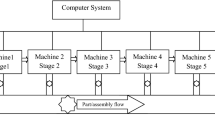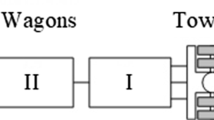Abstract
Our country has a vast territory, and rail transit is very important to the development of our country's national economy. In this paper, key technologies for a digital twin-based shop floor management and control system are investigated, and the concept is designed and implemented. By adding a digital twin between the business management layer and the production execution layer of the traditional workshop management and control system through the fuzzy rule neural network, a new workshop management and control system architecture on the basis of the virtual is formed, enabling intellectual management and control of the workshop. The results of the study found that the integration of the digital twin into the conventional shop floor management and control system led to changes in the composition, processes and information integration of the management and support system. For the purpose of comparing the system scheduling of the high-speed railway on the basis of the vague rule neural network with the traditional method, we made statistics on the system scheduling before and after the transformation. In terms of manufacturing volume, after the output exceeds 200, the speed of the traditional manufacturing method lags behind the fuzzy rule neural network by nearly 50%.










Similar content being viewed by others
Explore related subjects
Discover the latest articles, news and stories from top researchers in related subjects.Data availability
No data were used to support this study.
References
Lee J (2020) Integration of digital twin and deep learning in cyber-physical systems: towards smart manufacturing. 38(8):901–910. https://www.sciencedirect.com/science/article/abs/pii/S2213846319300264
Schroeder GN, Steinmetz C, Pereira CE et al (2016) Digital twin data modeling with automationML and a communication methodology for data exchange. IFAC-PapersOnLine 49(30):12–17
Zhang H, Liu Q, Chen X et al (2017) A digital twin-based approach for designing and multi-objective optimization of hollow glass production line. IEEE Access 2017(5):26901–26911
Ma Z, Sun G, Liu D et al (2016) Dissipativity analysis for discrete-time fuzzy neural networks with leakage and time-varying delays. Neurocomputing 175(JAN.29PT.A):579–584
Yucel E, Ali MS, Gunasekaran N et al (2016) Sampled-data filtering of Takagi-Sugeno fuzzy neural networks with interval time-varying delays. Fuzzy Sets Syst 316(JUN.1):69–81
Howe MS (2018) Pressure transients generated when high-speed trains pass in a tunnel. IMA J Appl Math 65(3):315–334
Park H, Kim J (2016) Electromagnetic induction energy harvester for high-speed railroad applications. Int J Precis Eng Manuf Green Technol 3(1):41–48
Li BR, Wang Y, Dai GH et al (2019) Framework and case study of cognitive maintenance in Industry 4.0. Front Inf Technol Electron Eng 20(11):1493–1504
Li L, Wang Y, Lin KY (2021) Preventive maintenance scheduling optimization based on opportunistic production-maintenance synchronization. J Intell Manuf 32(2):545–558
Pham BT, Bui DT et al (2016) Rotation forest fuzzy rule-based classifier ensemble for spatial prediction of landslides using GIS. Nat Hazards 83(1):97–127
Rubaai A, Young P (2016) Hardware/software implementation of fuzzy-neural-network self-learning control methods for brushless DC motor drives. IEEE Trans Ind Appl 52(1):414–424
Acikgoz H, Coteli R, Ustundag M et al (2018) Robust control of current controlled pwm rectifiers using type-2 fuzzy neural networks for unity power factor operation. J Electr Eng Technol 13(2):822–828
Ebrahimi A, Fritsching U, Heuser M et al (2020) A digital twin approach to predict and compensate distortion in a high pressure die casting (HPDC) process chain. Procedia Manuf 52(7):144–149
Jafari MA, Zaidan E, Ghofrani A et al (2020) Improving building energy footprint and asset performance using digital twin technology. IFAC-PapersOnLine 53(3):386–391
Xu K, Zeng J, Wei L (2019) An analysis of the self-excited torsional vibration of high-speed train drive system. J Mech Sci Technol 33(3):1149–1158
Kim JS, Park NG, Lee HW (2016) Vibration analysis of a planetary gear system based on the transfer matrix method. J Mech Sci Technol 30(2):611–621
Dong MG, Liu B, Jing C (2020) A many-objective evolutionary algorithm based on decomposition with dynamic resource allocation for irregular optimization. Front Inf Technol Electron Eng 21(8):1171–1190
Bill P (2016) Speed up damage assessment: assembly and dispatch of resources during outage events. Electr Today 29(4):8–10
Zhuang H, Li W, Yin Y et al (2018) Collaborative analysis of dispatch systems between high-speed and conventional rail. Xinan Jiaotong Daxue Xuebao/J Southwest Jiaotong Univ 53(3):467–473
Hembroff CC, Arbuthnott KD, Kratzig GP (2018) Emergency response driver training: dual-task decrements of dispatch communication. Transp Res Part F Traffic Psychol Behav 59(PT.A):222–235
Tan L, Wang H, Yang C et al (2017) A multi-objective optimization method based on discrete bacterial algorithm for environmental/economic power dispatch. Nat Comput 16(4):549–565
Zhang Y, Qin N, Huang D et al (2019) Fault diagnosis of high-speed train bogie based on deep neural network. IFAC-PapersOnLine 52(24):135–139
Alvarez-Sanjaime O, Cantos-Sanchez P, Moner-Colonques R et al (2016) Rail access charges and internal competition in high speed trains. Transp Policy 49(jul.):184–195
Wang C, Mao P, Mao Y et al (2016) Research on scheduling and optimization under uncertain conditions in panel block production line in shipbuilding. Int J Nav Archit Ocean Eng 8(4):398–408
Liu LL, Wan X, Gao Z et al (2019) Research on modelling and optimization of hot rolling scheduling. J Ambient Intell Humaniz Comput 10(3):1201–1216
Acknowledgements
This work was undertaken with the support of Science and Technology Nova Plan of Beijing City Fengtai District 2020-kjxx202006, and Beijing Nova Program (Z211100002121140).
Author information
Authors and Affiliations
Corresponding author
Ethics declarations
Conflict of interest
The author declares that there are no conflicts of interest regarding the publication of this article.
Additional information
Publisher's Note
Springer Nature remains neutral with regard to jurisdictional claims in published maps and institutional affiliations.
Rights and permissions
About this article
Cite this article
Peng, F., Zheng, L. Fuzzy rule-based neural network for high-speed train manufacturing system scheduling problem. Neural Comput & Applic 35, 2077–2088 (2023). https://doi.org/10.1007/s00521-022-07190-9
Received:
Accepted:
Published:
Issue Date:
DOI: https://doi.org/10.1007/s00521-022-07190-9




